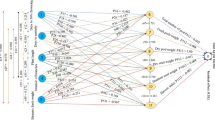Abstract
Increasing crop yield is a major challenge in modern agriculture. Thus, the relationships between yield and its impact traits in cotton breeding need to be studied. A genetic model with additive, dominance, and their interaction effect with environment was used to analyze the two-year data of 20 parents and 100 F1 hybrids from a 10 × 10 diallel cross (North Carolina II design) in intraspecific upland cotton (Gossypium hirsutum L.) hybrids of high planting density cases. The decision-making analysis of the other 11 traits on lint yield was performed based on correlation and path analyses. Results showed that the order of significant relationships of additive effect in terms of size between lint yield and other traits was as follows: boll weight; boll number of the top three fruit-bearing branches; total boll number; fiber length; micronaire; and plant height. The decision-making traits of lint yield were boll weight and total boll number, fiber length was a main restricting trait. For the genotypic value, the decision-making traits were boll weight and total boll number. The increased phenotypic values of the almost traits could increase lint yield, but high phenotypic values should be selected for total boll number and boll weight to obtain better results. Thus, the use of the decision-making coefficient approach to conduct indirect selection is more applicable than correlation and path analyses in breeding practices.
Similar content being viewed by others
References
Ball RA, McNew RW, Vories ED, Keisling TC, Purcel LC (2001) Path analyses of population density effects on short-season soybean yield. Agron J 93(1):187–195
Cooper Jessica K, Ibrahim AMH, Rudd J, Malla S, Hays DB, Baker J (2012) Increasing hard winter wheat yield potential via synthetic wheat: I path-coefficient analysis of yield and its components. Crop Sci 52(5):2014–2022
Cramer CS, Wehner TC (2000) Path analysis of the correlation between fruit number and plant traits of cucumber population. HortScience 35:708–711
Culp TW, Harrell DC (1975) Influence of lint percentage, boll size, and seed size on LY of upland cotton with high fiber strength. Crop Sci 15:741–746
Garcia del Moral LF, Ramos JM, Garcia del Moral MB, Jimenez-Tejada MP (1991) Ontogenetic approach to grain production in spring barley based on path-coefficient analysis. Crop Sci 31(5):1179–1185
Guler M, Adak MS, Ulukan H (2001) Determining relationships among yield and some yield components using path coefficient analysis in chickpea (Cicer arietinum L.). Eur J Agron 14(2):161–166
Jiao YQ, Wang YH, Xue DW, Wang J, Yan MX, Liu GF, Dong GJ, Zeng DL, Lu ZF, Zhu XD, Qian Q, Li JY (2010) Regulation of OsSPL14 by OsmiR156 defines ideal plant architecture in rice. Nat Genet 42(6):541–544
Maleki HH, Karimzadeh G, Darvishzadeh R, Sarrafi A (2011) Correlation and sequential path analysis of some agronomic traits in tobacco (Nicotiana tabaccum L.) to improve dry leaf yield. Aust J Crop Sci 5(12):1644–1648
Melchinger AE, Singh M, Link W, Utz HF, von Kittlitz E (1994) Heterosis and gene effects of multiplicative characters: theoretical relationships and experimental results from Vicia faba L. Theor Appl Genet 88(3–4):343–348
Miller R G (1974) The Jackknife: a review. Biometrika 61:1–15
Miyamoto N, Goto Y, Matsui M, Ukai Y, Morita M, Nemoto K (2004) Quantitative trait loci for phyllochron and tillering in rice. Theor Appl Genet 109(4):700–706
Samonte SOP, Wilson LT, McClung AM (1998) Path analyses of yield and yield-related traits of 15 diverse rice genotypes. Crop Sci 38(5):1130–1136
Schrag Tobias A, Jens Möhring, Peter Maurer Hans, Dhillon Baldev S, Melchinger Albrecht E, Hans-peter Piepho, Sørensen Anker P, Matthias Frisch (2009) Molecular marker-based prediction of hybrid performance in maize using unbalanced data from multiple experiments with factorial crosses. Theor Appl Genet 118(4):741–751
Sparnaaij LD, Bos I (1993) Components analysis of complex characters in plant breeding I. Proposed method for qualifying the relative contribution of individual components to variation of the complex characters. Euphytica 70:225–235
Tang B, Jenkins JN, Watson CE, McCarty JC, Creech RG (1996) Evaluation of genetic variances, heritabilities, and correlations for yield and fiber traits among cotton F2 hybrid populations. Euphytica 91:315–322
Worley S, Culp TW, Harrell DC (1974) The relative contributions of yield components to LY of upland cotton, Gossypium hirsutum L. Euphytica 23:399–403
Worley S, Ramey HH, Harrell DC, Culp TW (1976) Ontogenetic model of cotton yield. Crop Sci 16:30–34
Wu JX, Zhu J, Xu FH, Ji DF (1995) Analysis of genetic effect by environment interactions for yield traits in upland cotton (in Chinese). Heredita 17:1–4
Wu JX, Jenkins Johnie N, Mccarty Jack C Jr, Jun Zhu (2004) Genetic associations of yield with its component traits in a recombinant inbred line population of cotton. Euphytica 140:171–179
Wu JX, Jenkins Johnie N, Mccarty Jack C, Sukumar Saha, Richard Percy (2008) Genetic association of LY with its components in cotton chromosome substitution lines. Euphytica 164:199–207
Yuan ZF, Zhou JY, Guo MC (2001) Decision-making coefficient—the decision-making index of path analysis. J Northwest A & F Sci Technol Univ 29(5):131–133
Zhu J (1993) Methods of predicting genotype value and heterosis for offspring of hybrids. J Biomath 8:32–44
Zhu J, Weir BS (1994) Analysis of cytoplasm and maternal effects: I genetic models for diploid plant seeds and animals. Theor Appl Genet 89:153–159
Acknowledgments
This study was supported by the National High Technology Research Development 863 Plan (Grant No. 2009AA101104) and the National Cotton Industry Technology System (No. CARS–18). We thank Prof. ZF Yuan of Northwest F & A University, China for providing the test method of the decision-making coefficient used in this research.
Author information
Authors and Affiliations
Corresponding author
Additional information
Yongjun Mei and Weifeng Guo have contributed equally to this study.
Rights and permissions
About this article
Cite this article
Mei, Y., Guo, W., Fan, S. et al. Analysis of decision-making coefficients of the lint yield of upland cotton (Gossypium hirsutum L.). Euphytica 196, 95–104 (2014). https://doi.org/10.1007/s10681-013-1016-x
Received:
Accepted:
Published:
Issue Date:
DOI: https://doi.org/10.1007/s10681-013-1016-x




